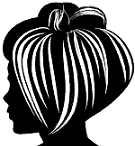Hey there, fabulous folks! Ever wondered what hair type you have and how to rock it with confidence? Whether your locks are curly, straight, wavy, or coily, understanding your hair type is crucial to maintaining those luscious tresses and flaunting them with pride.
Today, we’ll embark on a journey to discover the wonders of our hair and find out, the right way, what makes it special. So, let’s stop wondering and start knowing our beautiful manes better!
Understanding Hair Type

Before we delve into the process of identifying our hair type, let’s quickly go over the four main hair types and their subcategories:
Straight Hair: This hair type is smooth, sleek, and naturally straight without any noticeable waves or curls. It further divides into three subtypes:
a. 1A – Fine, thin, and delicate strands.
b. 1B – Medium-textured hair that’s a little thicker than 1A.
c. 1C – Coarse and thicker strands with a noticeable body.
Wavy Hair: Hair under this category is wavy, with a defined ‘S’ shape and varying degrees of texture. Type 2 hair has three subtypes:
a. 2A – Loose and gentle waves with a fine texture.
b. 2B – More defined waves that are a bit frizzier.
c. 2C – Prominent and coarse waves with a tendency to form curls.
Curly Hair: Curly hair is characterized by well-defined curls and has more volume compared to straight and wavy hair. It’s divided into three subtypes:
a. 3A – Loose and big curls with a natural sheen.
b. 3B – Springy curls that have a medium curl pattern.
c. 3C – Tight, corkscrew curls that may appear dense.
Coily Hair: This hair type has tight coils and appears densely packed. It has three subtypes:
a. 4A – Tightly coiled curls with a visible ‘S’ pattern.
b. 4B – Z-shaped curls that are less defined and more fragile.
c. 4C – Extremely tight coils that have minimal definition but stunning volume.
Now that we’ve got a basic understanding of the various hair types let’s move on to the exciting part of figuring out our own!
What is My Hair Type? How to Find Out, The Right Way
Time to unlock the mystery of your hair! Follow these simple steps to identify your hair type and say goodbye to hair care guessing games!
Wash and Dry Your Hair
- Start with a clean slate: Wash your hair with a gentle, sulfate-free shampoo to remove any product build-up and dirt. Remember, a squeaky-clean head is the first step to discovering your true hair type!
- Let it breathe: Allow your hair to air dry without any products, such as gels or serums. This step will give you a clearer picture of your natural hair texture.
The Visual Test
- Examine your hair: Stand in front of a well-lit mirror and observe your hair’s natural fall. Does it hang straight down, or do you notice any waves or curls forming?
- Pinpoint your hair type: Compare your hair with the descriptions of Type 1, 2, 3, and 4 to identify the broad category it belongs to. Pay attention to the shape and size of curls or waves.
The Texture Test
- Touch and feel: Run your fingers along a single strand of hair, paying attention to its texture. Is it fine, medium, or coarse?
- Tug and stretch: Gently stretch the strand to see how much elasticity it has. Curly and coily hair tends to stretch and bounce back, while straight hair shows little to no elasticity.
The Water Test
- Wet your hair: Take a small section of hair and wet it thoroughly with water.
- Observe the curl pattern: Analyze how your hair reacts when wet. Does it remain straight, form loose waves, or coil into tight curls? This test will help you further narrow down your hair type.
The Frizz Test
- Embrace the humidity: On a humid day, go outside and let your hair interact with the moisture in the air.
- Note the frizz: How does your hair react? If it tends to frizz and pouf up, it’s likely to be wavy or curly. On the other hand, if it remains sleek and straight, you might have Type 1 hair.
Seek Professional Advice
- Consult a hairstylist: If you’re still unsure about your hair type, don’t hesitate to seek advice from a professional hairstylist. They can analyze your hair and guide you through the process of understanding your unique hair type.
FAQ’S ABOUT hair type
A1: Absolutely! It’s common to have different hair types on the same head, especially if you have a mix of textures.
A2: Yes, your hair type can change due to various factors like hormonal fluctuations, aging, and lifestyle changes.
A3: Once you’ve identified your hair type, look for hair care products specifically formulated for that type to achieve the best results.

